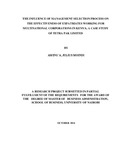| dc.description.abstract | Over the past few decades, the world‟s fundamental business and economic perspective
have greatly shifted. Today, the boundaries of a country do not in effect determine the
limits within which companies conduct their businesses and how they select their
employees. Many large companies have injected huge capital investments in branches
overseas in pursuit of new markets for their products, cheap labour or other factors of
production. The advent of international business and globalization have given birth to
multinational corporations (MNCs) which are ever confronted with the challenge of
selecting the best, effective, efficient and competent managers (expatriates) for their
international outlets. In order the get the most effective and efficient expatriates MNCs
must adopt an objective and water tight selection process. This research was conducted to
determine how the management selection process of expatriates affects the effectiveness
of those expatriates in Kenya and Tetra Pak was used as a case study. The contingency
approach to management as pioneered by Fred Fiedler which suggests that efficient
management techniques vary in different types of situations and circumstances was the
basis of this research. The hypothesis of the research was that the effectiveness on
expatriates depends on their individual characteristics and the company characteristics.
The research focused on the expatriate‟s personal characteristics that affect their
preference to be sent to undertake foreign assignments and how those characteristics
affected their effectiveness. In play here were characteristics such as age, gender,
international experience, location, nationalities, salary scale, areas of specialization,
family status, and other inherent qualifications and characteristics. Company
characteristics and policies were also taken into consideration. Data was collected from
the expatriates as well as from the HRM at Tetra Pak using interview guides. Additional
information about expatriate at Tetra Pak was gathered from websites and other print
media. The data that was collected was grouped into common recurring themes and was
analyzed using content analysis. The information was presented in tables, graphs and
charts. The study established that the selection process highly affect the effectiveness of
expatriates working for MNCs. The expatriates were satisfied with the selection process
as formulated by their employer. The study established that all of the respondents had
spouses but female expatriates were not staying with their partners. This depicts that the
majority of the expatriates valued their families but the company did not. Of interest was
the fact that Tetra Pak did not involve the spouses of the potential expatriates in the
selection process yet family situation was a key consideration for expatriation. It was
established that majority of the expatriates were from the home country of the MNC
therefore it was conclusive that ethnocentric selection approach was preferred by Tetra
Pak. The study also established that the selection of expatriates from within the
organization highly influenced their effectiveness. The use of a succession planning
model was very important in enhancing expatriate success. The study recommends
review of the existing policies to give family situation a higher consideration. There
being no expatriate aged below 30 years, it was recommended that the company
considers hiring young and vibrant expatriates. | en_US |

